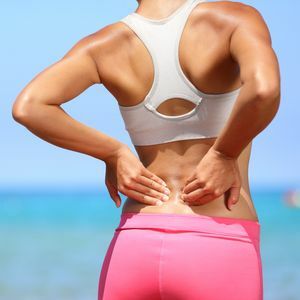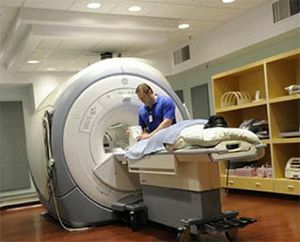 Protrusion is a disease associated with a degenerative-dystrophic disorder of the intervertebral disc. This condition is accompanied by pain in the lumbar region and back.
Protrusion is a disease associated with a degenerative-dystrophic disorder of the intervertebral disc. This condition is accompanied by pain in the lumbar region and back.
The disease can develop on the background of trauma or age-related changes. In the event that the nearby nerve is not pinched, the pain may be absent for a long time, so the person for a long time does not suspect about the presence of any violations.
Often the protrusion causes displacement of the vertebrae posteriorly, this mechanism is called "retrolisthesis".
The vertebral column hides the spinal cord and a variety of nerve roots. When the protrusion enters the spinal canal area, excessive pressure is applied to the spinal cord and roots, which contributes to the appearance of characteristic symptoms.
It is the lumbar spine that is most affected by the development of this pathology.
Content of the article
- Stages of development of the violation
- What lies at the root of the problem?
- How it looks and what it feels like
- protrusion forms
- diagnostics All the necessary measures
- Conservative therapy
- Surgical treatment
- Complex of exercise therapy
- Features of the
- nutrition regime Prophylactic approach
Stages of development of the
disorder There are several stages of protrusion development of the lumbar spine discs, each ofwhich has a definite clinical picture:
- Structural changes of - the disk is bulging. The pelvic nucleus deviates to the side and presses on the boundaries of the fibrous ring. Because of this, a bulge is formed, and in some cases it reaches half the circumference of the disc. There may be burning pains similar to flares, but often such a symptom is absent.
- Prolaps - the nucleus retains the fibrous ring, but there is an increase in convexity and pressure on the spine is intensified. The patient at the same time begins to experience discomfort, feels aching pain and burning sensation in the lumbar region.
- protrusion - the fibrous ring does not cope with the load, so part of the pulpous core goes beyond its limits. There are severe pains, arms and legs grow numb, edema of tissues develops.
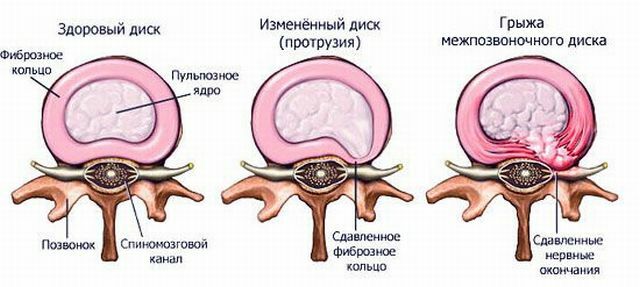
How protrusion and hernia develops
Because pain is usually absent in the beginning of the course of the disease, treatment begins already at more severe stages, when the situation becomes critical and requires serious intervention.
What lies at the root of the problem?
The main cause of the disease is excessive load on the lower back. Most often protrusion of spinal discs develops under the influence of several factors, among them:
- sedentary lifestyle;
- lack of physical activity or vice versa, excessive exercise;
- is a metabolic disorder;
- genetic predisposition( a certain structure of the lumbar pole);

- insufficiently developed muscular corset;
- crooked posture( scoliosis, kyphosis, lordosis);
- back injury;
- infectious diseases;
- osteochondrosis;
- excess weight;
- improper power supply;
- age changes in the body.
How it looks and what is felt
Symptoms in each case directly depend on the cause and stage in which the protrusion is located and can be:
- stiffness in the lower back;
- numbness of hands and feet;
- intense back pain of burning character;
- radiculitis;
- decreased mobility of the affected area;
- weakness in the muscles of the legs;
- fast fatigue;
- unpleasant sensations when climbing a mountain, with torso torso, and sitting;
- malfunction of the bladder( in some cases).
Forms of protrusion
There are several types of protrusion, each of which affects certain vertebrae: 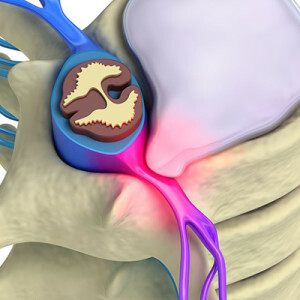
- Central .The protrusion occurs near the spinal canal. These protrusions are latent and often do not require intervention.
- The lateral is localized from the right or left side of the spine, most often deforms the roots in the spinal cord. This form is found in 10% of patients.
- Transdalateral .This pathology occurs most often. It is located at the back and side of the spine. Cramps the nerve roots and other components of SM.
- Rear .In this case, the disc protrudes from the abdomen to the back, breaking the functions of the pelvic organs.
Diagnosis
Diagnosis is established by performing CT or MRI procedures in the lumbar region. On the obtained pictures, the doctor should determine the location of the protrusion and its size.
Only after the received data it will be possible to select the most effective methods of therapy.
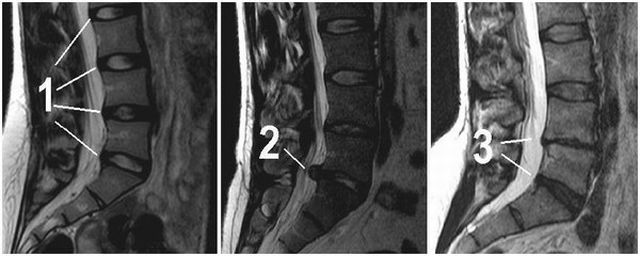
The whole complex of necessary measures
The sooner the treatment begins, the more chances that it will be possible to get rid of the protrusion of the spinal disk of the lumbar region in a conservative way. Objectives of therapy:
- pain relief;
- elimination of inflammation in tissues;
- removal of muscle spasms;
- strengthening of the back muscles;
- recovery of spine functions.
Conservative therapy
Treatment of protrusions of the lumbar region must necessarily be complex:
- Medication therapy .It is used in the acute stage of the disease. The action of the drugs is aimed at relief of pain, removal of inflammation and easing of pressure on the nerve roots. For this purpose, drugs of such groups are prescribed: analgesics, nonsteroidal agents, muscle relaxants, vitamin B. Sometimes injections of anesthetic, cortisone or steroids may be needed to reduce the irritation of the nerve roots. They act more slowly and can cause a painful reaction.

- Manual therapy .Massage should be done exclusively by a specialist. At the beginning of therapy, the procedures should be more gentle, then the massage technique changes. In this case, it is very important to avoid affecting the affected area of the back.
- Extension of the spine .The aim of the method is to increase the distance between the vertebrae and reduce the compression of the nerve roots. Systematic procedures allow you to remove the subluxation in the intervertebral joints and reduce the pressure inside the discs.
- Laser Therapy .It is used to normalize metabolism, ensure saturation of tissues in the affected area, improve immunity, as well as biochemical processes in the body. This method has an anti-inflammatory and analgesic effect.
- Magnetotherapy .Effective at all stages of the disease. It also strengthens the immune system and improves the condition of the circulatory system.
- Acupuncture .Used as an auxiliary method of therapy to reduce pain. Treatment gives a lasting result.
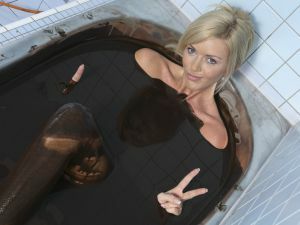
- Shockwave therapy .It is used as a preventive method. Promotes correction of posture, reducing pressure on the nerve roots, increasing the tone and strengthening the muscles of the back.
- Mud applications and baths .They remove inflammation, normalize blood circulation, relax spasms in muscles, promote tissue regeneration. The procedures are very effective in violation of sexual function, as well as in other complications of protrusion. In the period of acute pain, use of the application is prohibited.
Surgical treatment
It is used in rare cases, since surgical intervention can lead to such a negative effect as a hernia and in general aggravate the general condition of a person. The operation is necessary in those cases when:
- in the first half - year after the treatment there are no positive results;
- pathology progresses rapidly, and the lesion extends to healthy parts of the spinal column;
- fibrous ring protruded so much that there is a danger of complete loss of capacity.
The operation is a partial or complete removal of the affected area of the intervertebral disc and is performed only at the last stage of the disease, when the protrusion was transformed into a hernia.
The protrusion of the lumbar spine can provoke the development of a hernia, in which the nerve endings of the SM are jammed. Hernia is fraught with dysfunction of the pelvic organs and lumbago in the lower back.
In some cases, the pain can be so unbearable that the patient can not move and sit. Paralysis of the lower extremities may also develop.
Complex LFK
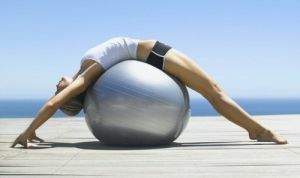 Physiotherapy is an integral part of protrusion treatment. Exercises contribute to improving motor activity and relieving inflammation. Classes can be held both in a specialized institution and at home.
Physiotherapy is an integral part of protrusion treatment. Exercises contribute to improving motor activity and relieving inflammation. Classes can be held both in a specialized institution and at home.
At the beginning of the therapeutic course, the load should be minimal, exercises should be performed in a lying condition with pauses in a few minutes between each.
Exercises that are effective in protruding the lumbar spine and which you can do on your own at home:
- Lie on your back with arms stretched out along your body and bend your knees slightly. Then strain the abdominal muscles, lower your legs, relax and repeat the movement.
- Lie in the same position, but lifting slightly the upper part of the back, the legs should be bent at the same time. Slowly lower your back, relax and repeat the movement.
- Lie down on the back with your legs bent to extend your left arm and rest against the knee of your right foot, while exerting the maximum pressure. Then change your leg.
All exercises must be repeated at least 10 times.
Well, if at home there is a Swedish wall or a horizontal bar, since the sagging on these projectiles is very useful for the spine. The procedure can be performed several times a day for several minutes.
It is desirable that a set of exercises selected by a specialist considering all the individual characteristics of the body. In no case should one begin to engage in the early stages of protrusion, since this can lead to exacerbation and aggravation of pain.
First and foremost, drug therapy is used, which allows to stop the focus of the disease, and then all other methods of therapy are used.
Two complexes of exercise therapy that are highly effective in hernia and protrusion of the lumbar spine:
Features of the
diet regime For patients with this pathology, proper nutrition is necessary. The purpose of the diet is to strengthen the vertebrae and bones. To compensate for calcium deficiency in the body, the following products are shown for consumption:
- fish;
- dairy products;
- beef;
- poultry meat;
- vegetables.

To restore the cartilage will be useful products containing gelatin:
- jelly;
- meat broth;
- jujube;
- jelly;
- seaweed.
Fried, spicy food with seasonings, as well as alcohol should be excluded from your diet.
Preventative approach
After the treatment it is very important to follow preventive measures that will preserve the health of the intervertebral disks:
- together with a doctor to choose a "useful" sport that will not have a detrimental effect on the spine( for example, it's contraindicated in weightlifting);
- make daily walks on foot;
- follow your posture, walk only with your head held up and your back straight;
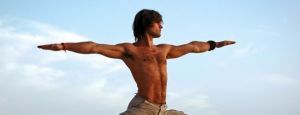
- try not to slouch, sitting on a chair leaning on the back;
- use orthopedic mattress;
- not to carry weights in one hand;
- get rid of bad habits;
- follow the excess weight.
The protrusion at the onset of the disease can be asymptomatic, and in the meantime the pathological processes will progress, and eventually the discomfort and severe pain that bind the movements will bring a lot of inconvenience to the patient and significantly reduce the quality of life.
The prognosis will be favorable if the treatment starts as soon as possible. Ignoring back pain can lead to the most unfortunate consequences, so if any signs of a disease are found, you need to seek medical help without delay.

